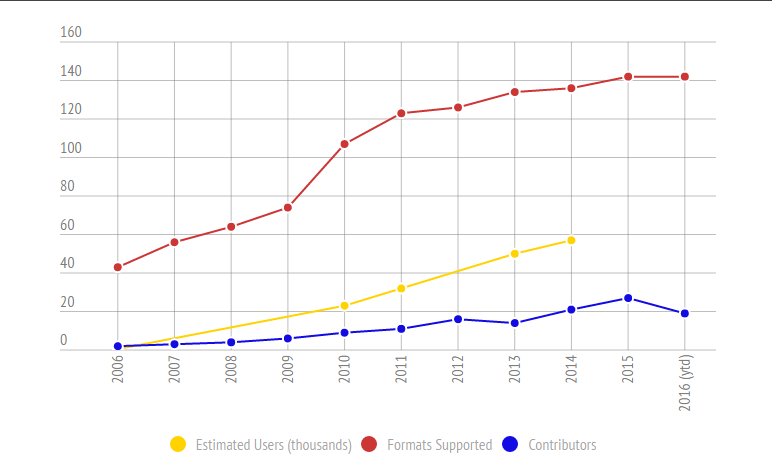Introduction to Bio-Formats
What is Bio-Formats?
- Java library for reading image-based datasets
- Reads images, but also acquisition metadata
- One API, many applications
- A complete implementation of OME-XML and OME-TIFF
A brief historical overview
- 2005 - work began on Java library
- 2006 March 31 - first official release of Bio-Formats
- late 2006 - OMERO begins using Bio-Formats
- early 2008 - MATLAB first supported
- 2008 - major effort standardize metadata handling across all formats
- 2009 (v4.0.0) - unified version numbers with OMERO
- late 2012/early 2013 - work began on C++ library
- 2014/2015 - major effort to improve performance
- 2015 - increasing number of contributed code changes
- 2016 - data model refinements and work on targeted projects (e.g. IDR)
The history in numbers














What can you do now?
Read images and metadata across many domains...
- light microscopy
- electron microscopy
- medical imaging (CT, PET, ...)
- high content screening (HCS)
- digital pathology/whole slide imaging (WSI)
- FLIM
- SPIM
...and in many different applications
Java:
ImageReader reader = new ImageReader();
IMetadata omeMetadata = MetadataTools.createOMEXMLMetadata();
reader.setMetadataStore(omeMetadata);
reader.setId("/PATH/TO/FILE");
for (int plane = 0; plane < reader.getImageCount(); plane++) {
byte[] image = reader.openBytes(plane);
Number timestamp = omeMetadata.getPlaneDeltaT(0, plane).value();
}
ImageJ macro:
run("Bio-Formats Macro Extensions");
Ext.setId("/PATH/TO/FILE");
Ext.getImageCount(imageCount);
timestamps = newArray(imageCount);
for (plane=0; plane < imageCount; plane++) {
Ext.openImage("image #" + plane, plane);
Ext.getPlaneTimingDeltaT(timestamps[plane], plane);
}
MATLAB:
r = bfGetReader("/PATH/TO/FILE");
imageCount = r.getImageCount();
omeMetadata = r.getMetadataStore();
for plane = 1:imageCount
image = bfGetPlane(r, plane, varargin{:});
timestamp = omeMetadata.getPlaneDeltaT(0, plane - 1).value().doubleValue();
end
Python:
reader = bioformats.get_image_reader(None, path="/PATH/TO/FILE")
imageCount = reader.rdr.getImageCount()
omeMetadata = javabridge.JWrapper(reader.rdr.getMetadataStore())
for plane in range(0, imageCount):
image = reader.read(series=0, index=plane, rescale=False)
timestamp = omeMetadata.getPlaneDeltaT(0, plane)
R:
reader = .jnew("loci.formats.ImageReader")
.jcall(reader, , "setId", file)
omeMetadata = .jcall(reader, "", "getMetadataStore")
image = .jcall(reader, "[B", "openBytes", 0)
timestamp = .jcall(omeMetadata, "", "getPlaneDeltaT", 0, 0)
Extensions to image reading
("reader wrappers")- cache reader state (Memoizer)
- group independent files into a single dataset (FileStitcher)
- return images in a specific layout (ChannelSeparator, ChannelMerger)
Memoizer
IFormatReader reader = new Memoizer(new ImageReader());
reader.setId("/PATH/TO/FILE");
- uses Kryo to serialize the reader's initialized state to a file
- initializing the same data file again uses the serialized state (i.e. faster)
FileStitcher
IFormatReader reader = new FileStitcher();
// reads 001.tiff, 002.tiff, ..., 010.tiff together
reader.setId("0< 01-10>.tiff");
- groups together files not otherwise detected as part of the same dataset
- useful for files with missing or unreadable metadata
ChannelSeparator/ChannelMerger
IFormatReader grayscaleImageReader = new ChannelSeparator();
IFormatReader rgbImageReader = new ChannelMerger();
- ChannelSeparator guarantees only grayscale images are returned
- ChannelMerger guarantees multi-channel datasets are returned as RGB images
Putting everything together...
IFormatReader reader = new Memoizer(new FileStitcher(new ChannelSeparator()));
- any combination of wrappers can be chained together
What we've done recently
- maintenance of 5.1.x
- 5.2.0
- performance and metadata updates for IDR
Bio-Formats 5.1.x series
See the Bio-Formats version history
- Reader bug fixes
- Support for native units across readers
- OMERO / Bio-Formats decoupling
- Documentation improvements
Bio-Formats 5.1.x series: community
See the Bio-Formats version history
- Readers (Metamorph, Slidebook, Fei, Imspector OBF)
- MATLAB toolbox
- Octave package
- OME-XML validation
Bio-Formats 5.2.0
Breaking changes
- New OME Data model
- Code generation improvements
- Drop of support for Java 6
- API (logging)
Bio-Formats IDR
- Lots of performance improvements for HCS formats
- Improved support for different types of Opera Flex plates
- More options for grouping together files without acquisition metadata
What's next?
- OME data model refinements
- Making existing features easier to use (e.g. units, MapAnnotation)
- Modernizing the data model development process
- Supporting our own formats
- Expanding examples and best practices documentation
- Working with other projects to support usage of OME-TIFF
- OME-HDF?
What's next...today?
- Supporting and maintaining OME file formats
- Questions? Concerns?
- Breakouts/technical discussion - look for the Bio-Formats sign!